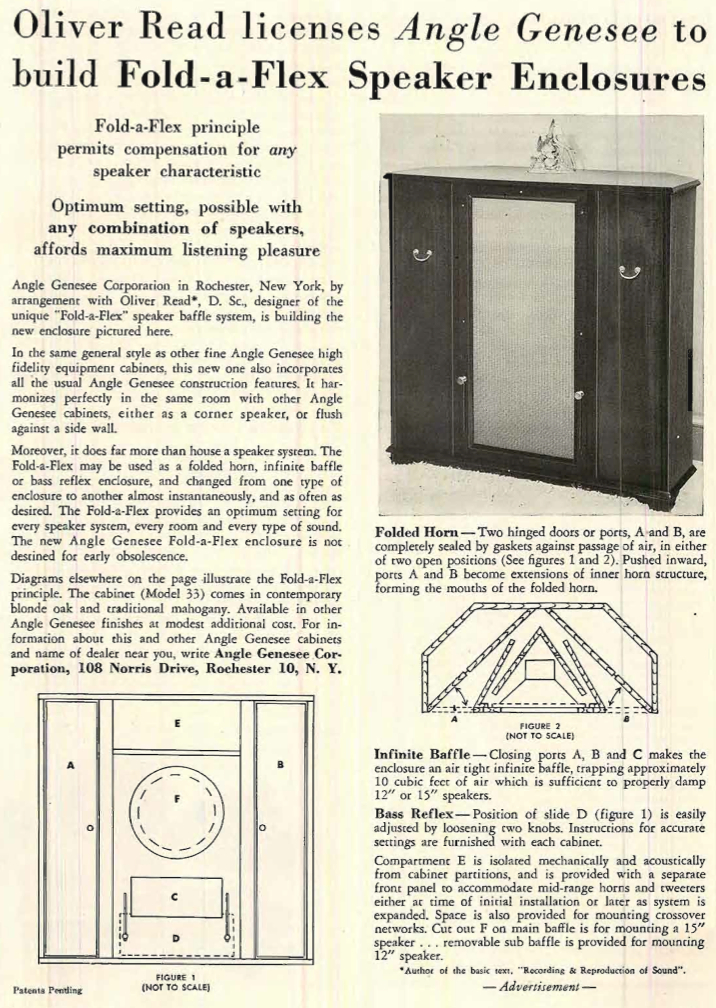Has anyone built, or just heard of, anyone who has made an adjustable speaker cabinet....maybe where an internal panel could be moved in increments ....to adjust the sound? Maybe a final panel in a TL speaker could be pivoted? Maybe where a section of stuffing could be slid up or down to affect the sound?
Yes, internal parts of a speaker must be secure to prevent rattling, but there are ways to do this: super tight hinges,....sections that can be tightened after being moved, etc.
Anyone toy with this?
Yes, internal parts of a speaker must be secure to prevent rattling, but there are ways to do this: super tight hinges,....sections that can be tightened after being moved, etc.
Anyone toy with this?
Like a water bladder! It won't compress.or something inflateable inside?
FWIW when I started with this "Audio thing" , late 60´s, and way before Thiele and Small, and where "measuring a speaker" was NASA Science for most, design equations were available (think Olson or Beranek books) but no data to fill them, a tried and true method to design a Bass Reflex cabinet was to cut a presumably oversize "too long" slot, cover it in part with a piece of plywood firmly held by 2 carpenter´s clamps and slide it here and there covering more or less of it, until a "best sounding" position was found. State of the art design  .
.
Oliver Read (a prolific contributor to early hi-fi magazines and co-author of "From Tin Toil to Stereo") had several loudspeaker designs - one the "Fold A Flex" - which could be converted from reflex to infinite baffle to a back loaded corner horn of sorts
Here's Read's Patent https://patentimages.storage.googleapis.com/39/97/a7/78c3a4322f25e7/US2805729.pdf


Here's Read's Patent https://patentimages.storage.googleapis.com/39/97/a7/78c3a4322f25e7/US2805729.pdf


I have.
100-400 hz in the box, more diffused the better?
I used it as a test box for sealed bass. Movable back panel w/ lid that clamps holds everything. It worked really well. I charted / noted each volume by 1/2” steps then picked the best one. Now I’m on to a midrange transformer box to do lots of experiments on. To me it’s worth the extra work to know for sure the internal space/shape is in the sweet spot.
100-400 hz in the box, more diffused the better?
I used it as a test box for sealed bass. Movable back panel w/ lid that clamps holds everything. It worked really well. I charted / noted each volume by 1/2” steps then picked the best one. Now I’m on to a midrange transformer box to do lots of experiments on. To me it’s worth the extra work to know for sure the internal space/shape is in the sweet spot.
Generically speaking, of course you want to make the system adjustable, every part of it. Since it is hard to refashion the carpentry, it makes sense to use DSP to EQ, time-warp, phase-slip, and individually adjust the signal to each driver.
I suppose there are people reading this who have never tested their room sound with REW and so they don't know they need a DSP EQ. Ignorance is bliss.
But given the need for solid construction, speakers - even though some depend on careful tuning - are adjustable just in damping. Like "aperiodic" BRs and TLs.
Whatever your (misbegotten) faith in sims and theory, once in the room, theory is just yesterday's tool.
With a folded three-section labyrinth, each section 6 feet long, I took 6 foot long rolls of fibreglass window screening, folded in half to make long tubular tubes, using dots of hot glue. Then I stuffed filler into the tubes.
17 foot pipe sub 12-230 Hz ±5dB - diyAudio
Long pipe to sequester rear wave - diyAudio
B.
I suppose there are people reading this who have never tested their room sound with REW and so they don't know they need a DSP EQ. Ignorance is bliss.
But given the need for solid construction, speakers - even though some depend on careful tuning - are adjustable just in damping. Like "aperiodic" BRs and TLs.
Whatever your (misbegotten) faith in sims and theory, once in the room, theory is just yesterday's tool.
....transmission line with sections that could be added or slid inside one another, it might have been bentoronto
With a folded three-section labyrinth, each section 6 feet long, I took 6 foot long rolls of fibreglass window screening, folded in half to make long tubular tubes, using dots of hot glue. Then I stuffed filler into the tubes.
17 foot pipe sub 12-230 Hz ±5dB - diyAudio
Long pipe to sequester rear wave - diyAudio
B.
- Status
- This old topic is closed. If you want to reopen this topic, contact a moderator using the "Report Post" button.
- Home
- Loudspeakers
- Multi-Way
- Transformers, not transformers!